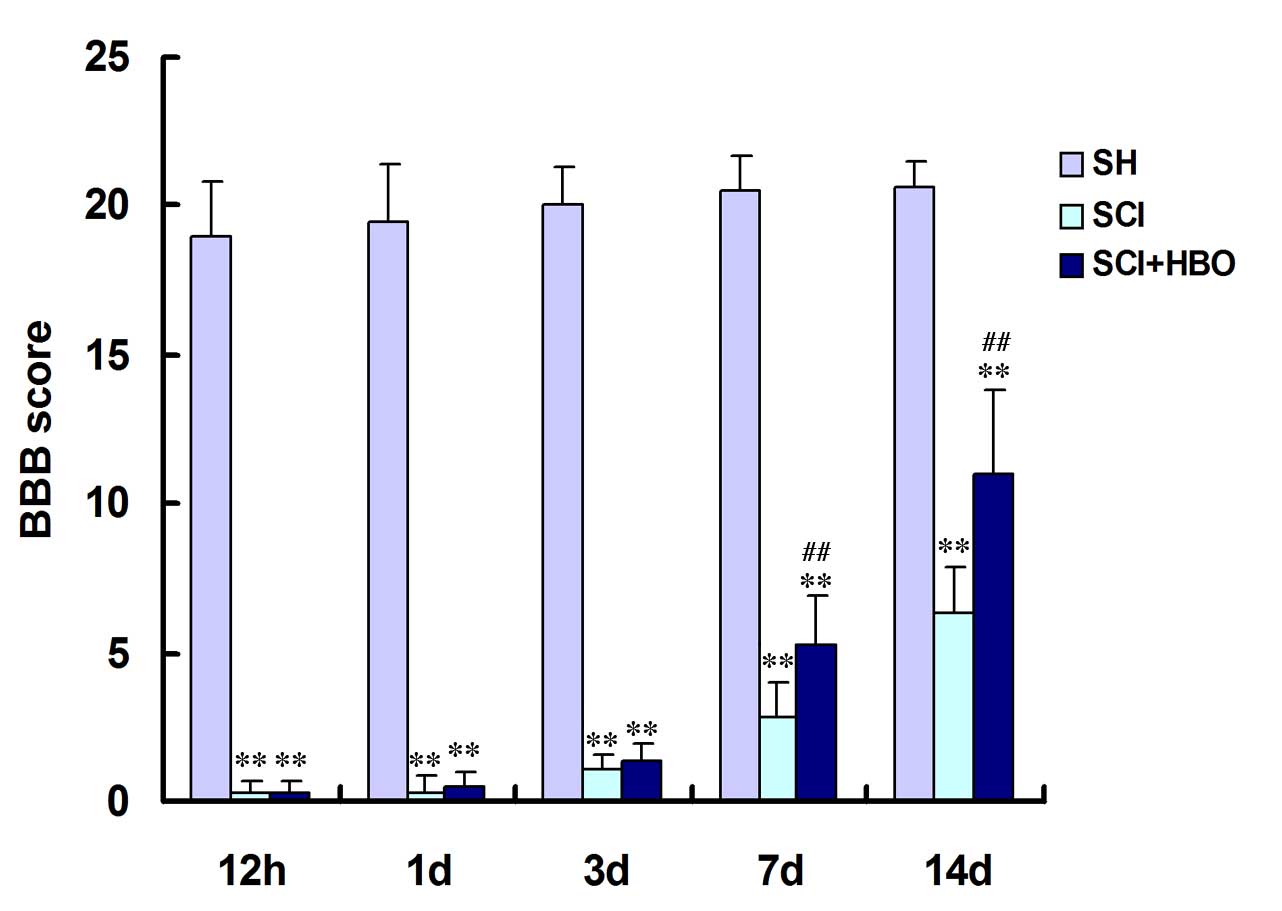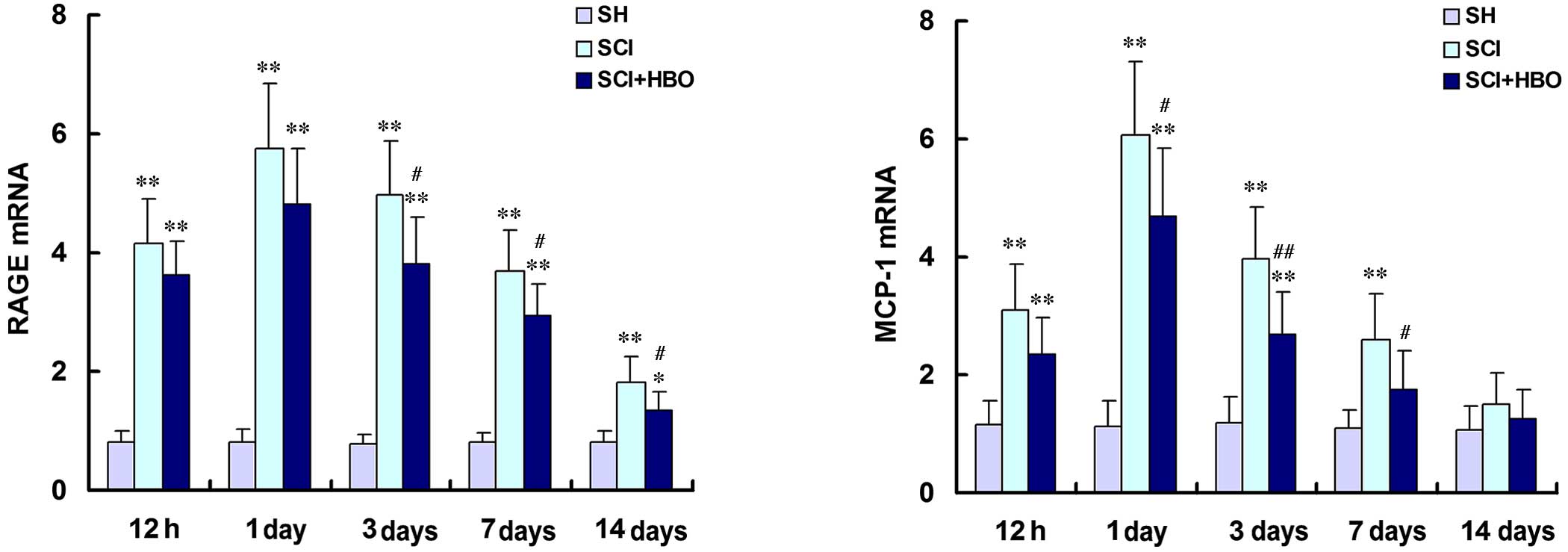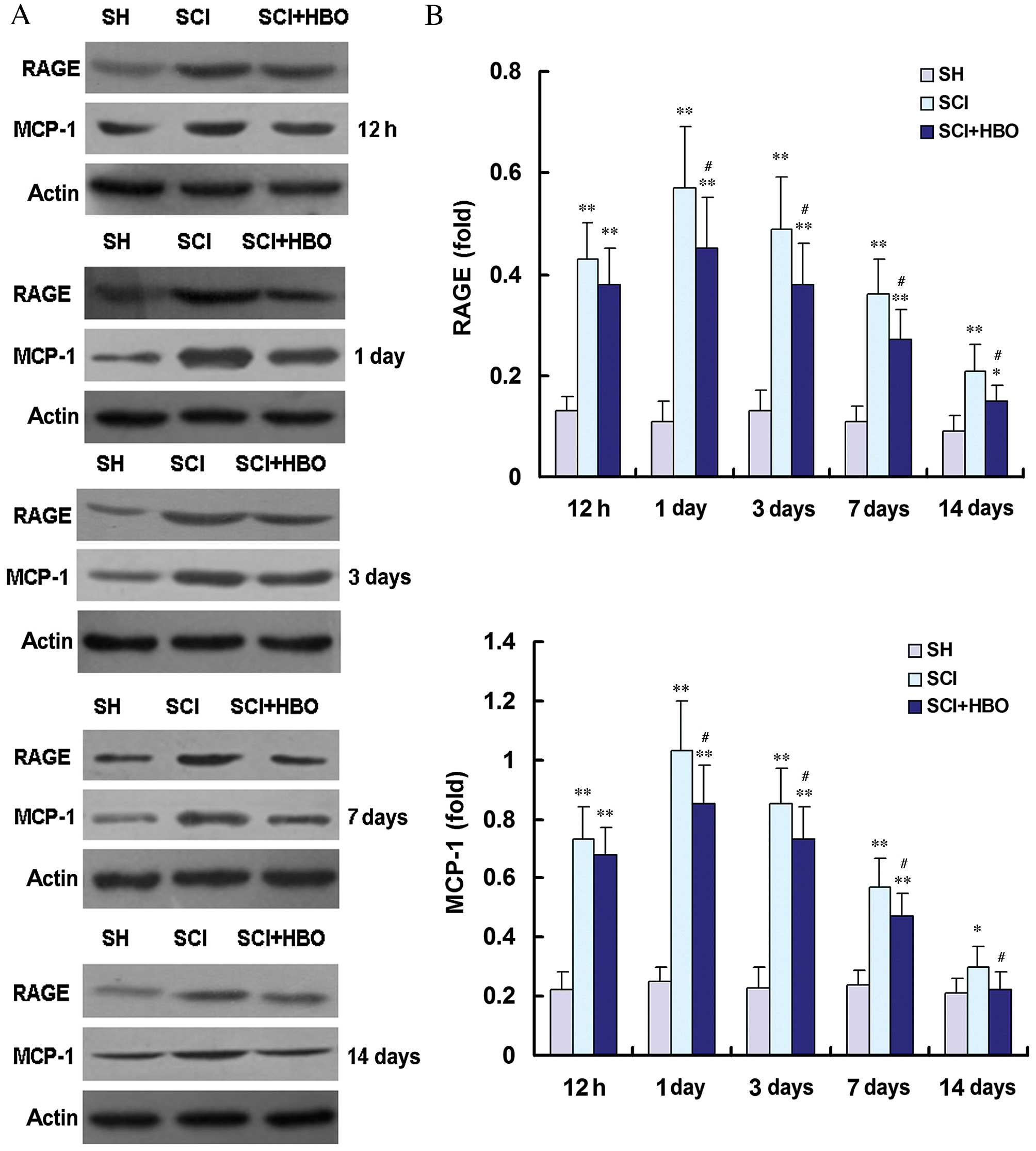|
1
|
Beattie MS, Hermann GE, Rogers RC and
Bresnahan JC: Cell death in models of spinal cord injury. Prog
Brain Res. 137:37–47. 2002. View Article : Google Scholar : PubMed/NCBI
|
|
2
|
Nie H, Xiong L, Lao N, Chen S, Xu N and
Zhu Z: Hyperbaric oxygen preconditioning induces tolerance against
spinal cord ischemia by upregulation of antioxidant enzymes in
rabbits. J Cereb Blood Flow Metab. 26:666–674. 2006. View Article : Google Scholar : PubMed/NCBI
|
|
3
|
Dayan K, Keser A, Konyalioglu S, Erturk M,
Aydin F, Sengul G and Dagci T: The effect of hyperbaric oxygen on
neuroregeneration following acute thoracic spinal cord injury. Life
Sci. 90:360–364. 2012. View Article : Google Scholar : PubMed/NCBI
|
|
4
|
Nakamura M, Houghtling RA, MacArthur L,
Bayer BM and Bregman BS: Differences in cytokine gene expression
profile between acute and secondary injury in adult rat spinal
cord. Exp Neurol. 184:313–325. 2003. View Article : Google Scholar : PubMed/NCBI
|
|
5
|
Fritz G: RAGE: A single receptor fits
multiple ligands. Trends Biochem Sci. 36:625–632. 2011. View Article : Google Scholar : PubMed/NCBI
|
|
6
|
Xie J, Mendez JD, Méndez-Valenzuela V and
Aguilar-Hernández MM: Cellular signalling of the receptor for
advanced glycation end products (RAGE). Cell Signal. 25:2185–2197.
2013. View Article : Google Scholar : PubMed/NCBI
|
|
7
|
Lin L, Park S and Lakatta EG: RAGE
signaling in inflammation and arterial aging. Front Biosci
(Landmark Ed). 14:1403–1413. 2009. View
Article : Google Scholar : PubMed/NCBI
|
|
8
|
Gao TL, Yuan XT, Yang D, Dai HL, Wang WJ,
Peng X, Shao HJ, Jin ZF and Fu ZJ: Expression of HMGB1 and RAGE in
rat and human brains after traumatic brain injury. J Trauma Acute
Care Surg. 72:643–649. 2012. View Article : Google Scholar : PubMed/NCBI
|
|
9
|
Muhammad S, Barakat W, Stoyanov S,
Murikinati S, Yang H, Tracey KJ, Bendszus M, Rossetti G, Nawroth
PP, Bierhaus A and Schwaninger M: The HMGB1 receptor RAGE mediates
ischemic brain damage. J Neurosci. 28:12023–12031. 2008. View Article : Google Scholar : PubMed/NCBI
|
|
10
|
Chen KB, Uchida K, Nakajima H, Yayama T,
Hirai T, Guerrero A Rodriguez, Kobayashi S, Ma WY, Liu SY, Zhu P
and Baba H: High-mobility group box-1 and its receptors contribute
to proinflammatory response in the acute phase of spinal cord
injury in rats. Spine (Phila Pa 1976). 36:2122–2129. 2011.
View Article : Google Scholar : PubMed/NCBI
|
|
11
|
Kwon BK, Stammers AM, Belanger LM,
Bernardo A, Chan D, Bishop CM, Slobogean GP, Zhang H, Umedaly H,
Giffin M, et al: Cerebrospinal fluid inflammatory cytokines and
biomarkers of injury severity in acute human spinal cord injury. J
Neurotrauma. 27:669–682. 2010. View Article : Google Scholar : PubMed/NCBI
|
|
12
|
Liu SQ, Ma YG, Peng H and Fan L: Monocyte
chemoattractant protein-1 level in serum of patients with acute
spinal cord injury. Chin J Traumatol. 8:216–219. 2005.PubMed/NCBI
|
|
13
|
Galasso JM, Liu Y, Szaflarski J, Warren JS
and Silverstein FS: Monocyte chemoattractant protein-1 is a
mediator of acute excitotoxic injury in neonatal rat brain.
Neuroscience. 101:737–744. 2000. View Article : Google Scholar : PubMed/NCBI
|
|
14
|
Allen EA, Erhardt EB and Calhoun VD: Data
visualization in the neurosciences: Overcoming the curse of
dimensionality. Neuron. 74:603–608. 2012. View Article : Google Scholar : PubMed/NCBI
|
|
15
|
Basso DM, Beattie MS and Bresnahan JC: A
sensitive and reliable locomotor rating scale for open field
testing in rats. J Neurotrauma. 12:1–21. 1995. View Article : Google Scholar : PubMed/NCBI
|
|
16
|
Yang L, Jones NR, Blumbergs PC, Van Den
Heuvel C, Moore EJ, Manavis J, Sarvestani GT and Ghabriel MN:
Severity-dependent expression of pro-inflammatory cytokines in
traumatic spinal cord injury in the rat. J Clin Neurosci.
12:276–284. 2005. View Article : Google Scholar : PubMed/NCBI
|
|
17
|
Anik I, Kokturk S, Genc H, Cabuk B, Koc K,
Yavuz S, Ceylan S, Ceylan S, Kamaci L and Anik Y:
Immunohistochemical analysis of TIMP-2 and collagen types I and IV
in experimental spinal cord ischemia-reperfusion injury in rats. J
Spinal Cord Med. 34:257–264. 2011. View Article : Google Scholar : PubMed/NCBI
|
|
18
|
Livak KJ and Schmittgen TD: Analysis of
relative gene expression data using real-time quantitative PCR and
the 2(−Delta Delta C(T)) Method. Methods. 25:402–408. 2001.
View Article : Google Scholar : PubMed/NCBI
|
|
19
|
Kwon BK, Tetzlaff W, Grauer JN, Beiner J
and Vaccaro AR: Pathophysiology and pharmacologic treatment of
acute spinal cord injury. Spine J. 4:451–464. 2004. View Article : Google Scholar : PubMed/NCBI
|
|
20
|
Sinescu C, Popa F, Grigorean VT, Onose G,
Sandu AM, Popescu M, Burnei G, Strambu V and Popa C: Molecular
basis of vascular events following spinal cord injury. J Med Life.
3:254–261. 2010.PubMed/NCBI
|
|
21
|
Miron VE, Boyd A, Zhao JW, Yuen TJ, Ruckh
JM, Shadrach JL, van Wijngaarden P, Wagers AJ, Williams A, Franklin
RJ and ffrench-Constant C: M2 microglia and macrophages drive
oligodendrocyte differentiation during CNS remyelination. Nat
Neurosci. 16:1211–1218. 2013. View
Article : Google Scholar : PubMed/NCBI
|
|
22
|
Xue H, Zhang XY, Liu JM, Song Y, Liu TT
and Chen D: NDGA reduces secondary damage after spinal cord injury
in rats via anti-inflammatory effects. Brain Res. 1516:83–92. 2013.
View Article : Google Scholar : PubMed/NCBI
|
|
23
|
Tibbles PM and Edelsberg JS:
Hyperbaric-oxygen therapy. N Engl J Med. 334:1642–1648. 1996.
View Article : Google Scholar : PubMed/NCBI
|
|
24
|
Topuz K, Colak A, Cemil B, Kutlay M,
Demircan MN, Simsek H, Ipcioglu O, Kucukodaci Z and Uzun G:
Combined hyperbaric oxygen and hypothermia treatment on oxidative
stress parameters after spinal cord injury: An experimental study.
Arch Med Res. 41:506–512. 2010. View Article : Google Scholar : PubMed/NCBI
|
|
25
|
Liu X, Zhou Y, Wang Z, Yang J, Gao C and
Su Q: Effect of VEGF and CX43 on the promotion of neurological
recovery by hyperbaric oxygen treatment in spinal cord-injured
rats. Spine J. 14:119–127. 2014. View Article : Google Scholar : PubMed/NCBI
|
|
26
|
Lu PG, Feng H, Yuan SJ, Zhang RW, Li M, Hu
R, Liu ZS and Yin J: Effect of preconditioning with hyperbaric
oxygen on neural cell apoptosis after spinal cord injury in rats. J
Neurosurg Sci. 57:253–258. 2013.PubMed/NCBI
|
|
27
|
Yang J, Liu X, Zhou Y, Wang G, Gao C and
Su Q: Hyperbaric oxygen alleviates experimental (spinal cord)
injury by downregulating HMGB1/NF-κB expression. Spine (Phila Pa
1976). 38:E1641–E1648. 2013. View Article : Google Scholar : PubMed/NCBI
|
|
28
|
Tan J, Zhang F, Liang F, Wang Y, Li Z,
Yang J and Liu X: Protective effects of hyperbaric oxygen treatment
against spinal cord injury in rats via toll-like receptor 2/nuclear
factor-κB signaling. Int J Clin Exp Pathol. 7:1911–1919.
2014.PubMed/NCBI
|
|
29
|
Chen X, Duan XS, Xu LJ, Zhao JJ, She ZF,
Chen WW, Zheng ZJ and Jiang GD: Interleukin-10 mediates the
neuroprotection of hyperbaric oxygen therapy against traumatic
brain injury in mice. Neuroscience. 266:235–243. 2014. View Article : Google Scholar : PubMed/NCBI
|
|
30
|
Leskovar A, Moriarty LJ, Turek JJ,
Schoenlein IA and Borgens RB: The macrophage in acute neural
injury: Changes in cell numbers over time and levels of cytokine
production in mammalian central and peripheral nervous systems. J
Exp Biol. 203:1783–1795. 2000.PubMed/NCBI
|
|
31
|
Tjoa T, Strausbaugh HJ, Maida N, Dazin PF,
Rosen SD and Noble-Haeusslein LJ: The use of flow cytometry to
assess neutrophil infiltration in the injured murine spinal cord. J
Neurosci Methods. 129:49–59. 2003. View Article : Google Scholar : PubMed/NCBI
|
|
32
|
Carlson SL, Parrish ME, Springer JE, Doty
K and Dossett L: Acute inflammatory response in spinal cord
following impact injury. Exp Neurol. 151:77–88. 1998. View Article : Google Scholar : PubMed/NCBI
|
|
33
|
Stern D, Yan SD, Yan SF and Schmidt AM:
Receptor for advanced glycation endproducts: A multiligand receptor
magnifying cell stress in diverse pathologic settings. Adv Drug
Deliv Rev. 54:1615–1625. 2002. View Article : Google Scholar : PubMed/NCBI
|
|
34
|
Kawabata H, Setoguchi T, Yone K, Souda M,
Yoshida H, Kawahara K, Maruyama I and Komiya S: High mobility group
box 1 is upregulated after spinal cord injury and is associated
with neuronal cell apoptosis. Spine (Phila Pa 1976). 35:1109–1115.
2010. View Article : Google Scholar : PubMed/NCBI
|
|
35
|
Guo JD, Li L, Shi YM, Wang HD, Yuan YL,
Shi XX and Hou SX: Genetic ablation of receptor for advanced
glycation end products promotes functional recovery in mouse model
of spinal cord injury. Mol Cell Biochem. 390:215–223. 2014.
View Article : Google Scholar : PubMed/NCBI
|
|
36
|
Li H, Wu W, Sun Q, Liu M, Li W, Zhang XS,
Zhou ML and Hang CH: Expression and cell distribution of receptor
for advanced glycation end-products in the rat cortex following
experimental subarachnoid hemorrhage. Brain Res. 1543:315–323.
2014. View Article : Google Scholar : PubMed/NCBI
|
|
37
|
Schmidt AM, Yan SD, Yan SF and Stern DM:
The multiligand receptor RAGE as a progression factor amplifying
immune and inflammatory responses. J Clin Invest. 108:949–955.
2001. View Article : Google Scholar : PubMed/NCBI
|
|
38
|
Che X, Ye W, Panga L, Wu DC and Yang GY:
Monocyte chemoattractant protein-1 expressed in neurons and
astrocytes during focal ischemia in mice. Brain Res. 902:171–177.
2001. View Article : Google Scholar : PubMed/NCBI
|
|
39
|
Stammers AT, Liu J and Kwon BK: Expression
of inflammatory cytokines following acute spinal cord injury in a
rodent model. J Neurosci Res. 90:782–790. 2012. View Article : Google Scholar : PubMed/NCBI
|
|
40
|
Sandhir R, Gregory E, He YY and Berman NE:
Upregulation of inflammatory mediators in a model of chronic pain
after spinal cord injury. Neurochem Res. 36:856–862. 2011.
View Article : Google Scholar : PubMed/NCBI
|
|
41
|
Zhang X, Chen C, Ma S, Wang Y and Su X:
Inhibition of monocyte chemoattractant peptide-1 decreases
secondary spinal cord injury. Mol Med Rep. 11:4262–4266.
2015.PubMed/NCBI
|
|
42
|
McTigue DM, Tani M, Krivacic K, Chernosky
A, Kelner GS, Maciejewski D, Maki R, Ransohoff RM and Stokes BT:
Selective chemokine mRNA accumulation in the rat spinal cord after
contusion injury. J Neurosci Res. 53:368–376. 1998. View Article : Google Scholar : PubMed/NCBI
|














